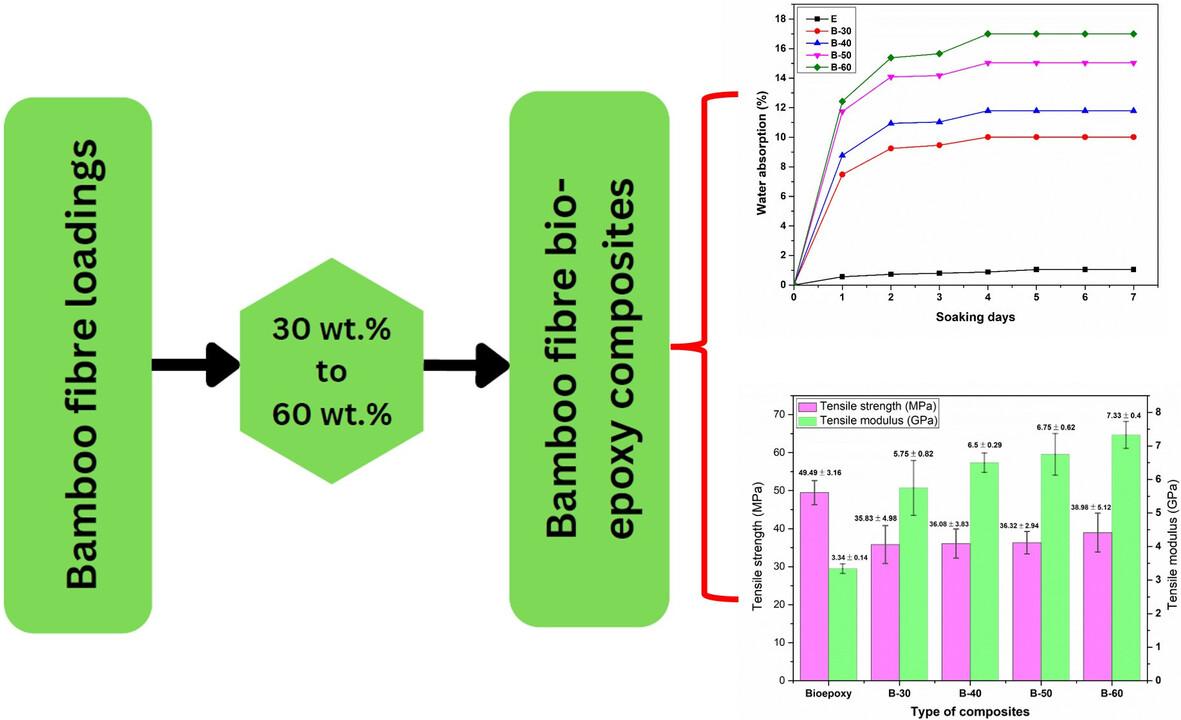求助PDF
{"title":"纤维负载对竹纤维和生物环氧复合材料的密度、空隙、尺寸回弹性、拉伸特性和热机械行为的影响","authors":"M. Chandrasekar, K. Senthilkumar, Hassan Fouad, Mohammad Jawaid, Mohamed Hashem, Ahmad Safwan Ismail, Naheed Saba, Ramzi Khiari","doi":"10.1002/pi.6608","DOIUrl":null,"url":null,"abstract":"<p>This paper investigates the influence of bamboo fibre loadings (30, 40, 50 and 60 wt%) on the physical, tensile and dimensional behaviour of short-bamboo-fibre-reinforced bio-epoxy matrix composites. Water absorption, thickness swelling, density, void content, tensile and thermomechanical analysis were determined. The findings indicated that higher fibre loading led to elevated water absorption and increased thickness swelling in bamboo fibre composites. The order of thickness swelling and water absorption behaviour was bio-epoxy < B-30 < B-40 < B-50 < B-60. Similarly, the measured density of composites increased with respect to fibre loading. However, the void content decreased when the fibre loading was >40 wt%. Concerning tensile characteristics, it was observed that all composite materials displayed lower tensile strength compared to the bio-epoxy matrix. However, there was a notable enhancement in the elasticity of the composites. As an example, B-60 exhibited the highest Young's modulus at 7.33 GPa. The analysis of the fracture behaviour of tension-tested samples was conducted using images obtained from SEM. The coefficient of thermal expansion was increased drastically as fibre loading increased. This indicated that the dimensional change was higher. Thus, it is desirable to have lower fibre loading to obtain better dimensional stability under the influence of temperature. © 2023 Society of Industrial Chemistry.</p>","PeriodicalId":20404,"journal":{"name":"Polymer International","volume":"73 5","pages":"378-384"},"PeriodicalIF":2.9000,"publicationDate":"2023-12-22","publicationTypes":"Journal Article","fieldsOfStudy":null,"isOpenAccess":false,"openAccessPdf":"","citationCount":"0","resultStr":"{\"title\":\"Influence of fibre loading on the density, voids, dimensional resilience, tensile characteristics and thermomechanical behaviour of bamboo fibre and bio-epoxy composites\",\"authors\":\"M. Chandrasekar, K. Senthilkumar, Hassan Fouad, Mohammad Jawaid, Mohamed Hashem, Ahmad Safwan Ismail, Naheed Saba, Ramzi Khiari\",\"doi\":\"10.1002/pi.6608\",\"DOIUrl\":null,\"url\":null,\"abstract\":\"<p>This paper investigates the influence of bamboo fibre loadings (30, 40, 50 and 60 wt%) on the physical, tensile and dimensional behaviour of short-bamboo-fibre-reinforced bio-epoxy matrix composites. Water absorption, thickness swelling, density, void content, tensile and thermomechanical analysis were determined. The findings indicated that higher fibre loading led to elevated water absorption and increased thickness swelling in bamboo fibre composites. The order of thickness swelling and water absorption behaviour was bio-epoxy < B-30 < B-40 < B-50 < B-60. Similarly, the measured density of composites increased with respect to fibre loading. However, the void content decreased when the fibre loading was >40 wt%. Concerning tensile characteristics, it was observed that all composite materials displayed lower tensile strength compared to the bio-epoxy matrix. However, there was a notable enhancement in the elasticity of the composites. As an example, B-60 exhibited the highest Young's modulus at 7.33 GPa. The analysis of the fracture behaviour of tension-tested samples was conducted using images obtained from SEM. The coefficient of thermal expansion was increased drastically as fibre loading increased. This indicated that the dimensional change was higher. Thus, it is desirable to have lower fibre loading to obtain better dimensional stability under the influence of temperature. © 2023 Society of Industrial Chemistry.</p>\",\"PeriodicalId\":20404,\"journal\":{\"name\":\"Polymer International\",\"volume\":\"73 5\",\"pages\":\"378-384\"},\"PeriodicalIF\":2.9000,\"publicationDate\":\"2023-12-22\",\"publicationTypes\":\"Journal Article\",\"fieldsOfStudy\":null,\"isOpenAccess\":false,\"openAccessPdf\":\"\",\"citationCount\":\"0\",\"resultStr\":null,\"platform\":\"Semanticscholar\",\"paperid\":null,\"PeriodicalName\":\"Polymer International\",\"FirstCategoryId\":\"92\",\"ListUrlMain\":\"https://onlinelibrary.wiley.com/doi/10.1002/pi.6608\",\"RegionNum\":4,\"RegionCategory\":\"化学\",\"ArticlePicture\":[],\"TitleCN\":null,\"AbstractTextCN\":null,\"PMCID\":null,\"EPubDate\":\"\",\"PubModel\":\"\",\"JCR\":\"Q2\",\"JCRName\":\"POLYMER SCIENCE\",\"Score\":null,\"Total\":0}","platform":"Semanticscholar","paperid":null,"PeriodicalName":"Polymer International","FirstCategoryId":"92","ListUrlMain":"https://onlinelibrary.wiley.com/doi/10.1002/pi.6608","RegionNum":4,"RegionCategory":"化学","ArticlePicture":[],"TitleCN":null,"AbstractTextCN":null,"PMCID":null,"EPubDate":"","PubModel":"","JCR":"Q2","JCRName":"POLYMER SCIENCE","Score":null,"Total":0}
引用次数: 0
引用
批量引用



